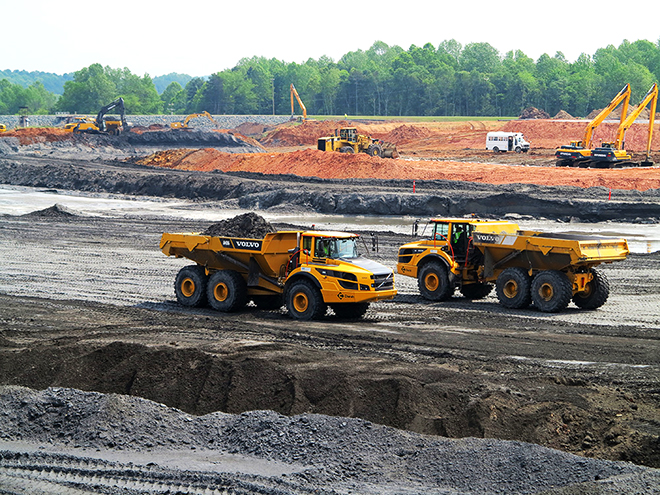US Companies Tap Coal, Waste for Rare Earth Metals

By Taylor Kuykendall
September 17, 2021 - Energy and environmental companies are advancing projects that can tap into valuable rare earth materials locked up in coal and coal waste, a potential boon for power generators, mine operators and mining communities that is supported by the U.S. government.
As U.S. coal production winds down due to a secular decline in demand from the power sector, advances in technology may offer new revenue streams from the resource. These advances include tapping into coal and its waste streams to extract rare earth metals, a valuable set of 17 elements used in a variety of applications, such as electronics, wind turbines and other technologies.

Coal ash is excavated from basins at Duke Energy's Riverbend Steam Station in North Carolina. Researchers and companies are looking into ways to extract valuable materials from coal and coal waste.
Source: Duke Energy Corp.
The rare earth resource in coal has attracted attention from policymakers and the mining industry. They see the potential to help coal communities and coal companies that have had economic decline as power generators transition to other energy sources. They also see the potential to reduce U.S. reliance on other countries for rare earth supply. China provided about 80% of U.S. rare earth imports between 2016 and 2019, according to the U.S. Geological Survey.
"We need to rapidly scale domestic production of these essential minerals, and we must invest in technology solutions — such as coal-to-rare earths — to help meet the size and urgency of the coming demand," said Conor Bernstein, a spokesperson for the National Mining Association.
The U.S. Energy Department's National Energy Technology Laboratory has touted three pilot-scale facilities producing small quantities of mixed rare earth oxides from coal products. Organizations, including a team of researchers at U.S. universities with DOE funding, are working on projects to extract rare earth metals from coal and its waste streams.
Cleaning Up Coal Waste
Midwest Energy Emissions Corp., also known as ME2C Environmental, announced Sept. 15 that it completed an initial round of testing on its rare earth element technology through the Pennsylvania State University's College of Earth and Mineral Sciences. The process captures rare earth materials from coal ash and wastewater produced by coal-fired power plants.
Richard MacPherson, CEO of ME2C Environmental, said the obligation to clean up coal ponds and contaminated runoff is one of the most significant economic and environmental responsibilities for the U.S. energy sector. Companies recycled 52% of the 78.6 million tons of coal ash produced in 2019, according to the American Coal Ash Association. Extracting rare earth materials could boost the profitability of cleaning up the waste that burning coal generates.
"There are a lot of situations where they want to clean them up, but they can't afford it," MacPherson said of power generators with large coal ash ponds. ME2C would offer companies a license to the technology to create value from an otherwise expensive clean-up process.
"It doesn't matter whether the coal industry as a power production segment is increasing or staying the same or declining," MacPherson said in an interview. "The coal ash problem that has been created over the last five decades or so is going to exist beyond the coal operation period. It needs to be addressed and cleaned up."
The environmental solutions company, which originally focused on removing mercury from coal-fired power plant emissions, expected to move forward with in-field, pilot-scale testing of its rare earth process later this year.
At a utility regulation summit in July, Alex Moyes, director of innovation at Dominion Energy Inc., said the Virginia-headquartered company's electric utility business is looking into pilot projects. It is already testing concentrations of rare earth elements in the coal at some of its power plants.
At the same event, Grant Bromhal, acting director of the DOE's minerals sustainability division within the Office of Fossil Energy and Carbon Management, said the U.S. could become a net exporter of rare earth metals, in part due to the ability to extract the elements from coal and coal waste materials.
New Focus for Coal Company
American Resources Corp. is another company looking to take advantage of the rare earth materials in coal and coal waste. In August, the company announced that the DOE selected it as part of a consortium to identify rare earth elements from coal resource feedstocks. The company started in the coal mining business and expanded by purchasing assets from coal companies in bankruptcy court sales during a wave of restructurings that swept through the industry.
"I'll be honest. We looked into rare earths just to look at how do you get rid of liability," American Resources CEO Mark Jensen said in an interview.
The effort has since expanded. The company described a diversified business model that includes metallurgical coal production, metals recycling and a growing rare earth business.
"There has been a massive paradigm shift in the [coal] industry," said Mark LaVerghetta, American Resources' vice president of corporate finance and communications. "You can either adapt and change or you can remain stagnant and continue to do things the same way and die."
American Resources recently announced it selected a site in Noblesville, Ind., that could be one of the first and only commercial-scale facilities capable of purifying and isolating rare earth elements in the United States. The proposed facility would handle multiple feedstocks, including coal waste, recycled permanent magnets and lithium-ion batteries.
Jensen said it is not economically viable to tap into coal deposits or reprocessing waste streams just for the rare earth elements. However, integrating rare earth extraction into other business processes can offset the costs of environmental obligations, Jensen said.
American Resources is looking elsewhere for revenue. For example, the company is recycling magnets and works with wind companies to extract valuable materials from their used generators, Jensen said.
"I hope people continue to look for different solutions because, at the end of the day, there's going to be a shortage," Jensen said of rare earth metals. "No one supplier is going to be able to fix this problem."

